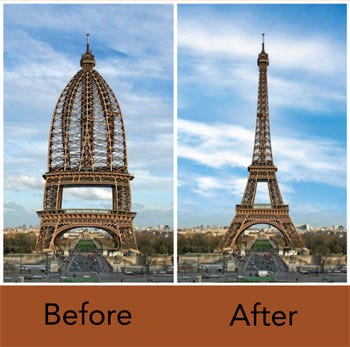When in uncharted territory
It's useful to embrace the complexity of history rather than the simplicity of case studies.
Simplicity tempts us with the allure of its formulas and quadrants, where everything is neat and ordered. It’s an era of short attention spans, and an age of desire for perfection. Control is within the scope of perfection, lest we overlook it.
Make everything efficient again, say some. They don’t think to ask for whom and what motivates the impulse, or to notice how systems work, so they break them. Culture doesn’t flip overnight, nor we acquire instant understanding of what to change to be effective without experience.
Complexity produces a richer texture of knowledge, as it takes into account the relationships between things. From knowledge we can build a more thoughtful understanding. That has power to change the way we look at things. And when we do that, we shift from copying tactics,1 to devising strategies.
The study of history, if we’re serious, requires a certain degree of curiosity and willingness to explore different angles. There’s no change without work; we can do no work without energy. Culture in the past tense is somewhat retrievable—we have first person accounts, ledgers, documents, recordings from different sides.

Case studies can have useful applications. However, history can teach us to understand how things work, we can learn from sampling the past—humans stay (fundamentally) the same.
Reminder: You can support my work and get extra insights—in-depth information, ideas, and interviews on the value of culture.
Join the premium list to access new series, topic break-downs, and The Vault.
The construction of our case
‘Case study’ is an expression marketers and sales professionals borrowed from science. As such, there are at least four types, each to serve a different purpose:
/ Illustrative are primarily descriptive to make the unfamiliar familiar and to provide us with a common language about the topic in question.
/ Exploratory or pilot are condensed case studies performed before implementing a large scale investigation. Their basic function is to help identify questions and select types of measurement prior to the main investigation, but we should be careful to test our assumptions about conclusions.
/ Cumulative serve the purpose of not incurring additional expenses when enough information already exists in past studies. Pulling information collected at different times allows us to generalize with a certain degree of accuracy.
/ Critical instance serve the purpose of examining a situation of unique interest to answer cause and effect questions.
When we talk about case studies in marketing, what we mean is simpler, although getting to the results takes work. We mean telling the story of how we progressed through solving a problem or identifying an opportunity to deliver results.
Case studies are also called success stories. They work best when the narrator is the customer and the story is in their own words. But we can help gather the right information to be relevant to whomever we’re trying to persuade.
The structure of a case study varies slightly, depending on its use. However, generally there is one way to construct the flow:
Protagonist—the people we’d like to attract.
Situation or challenge—the problem that needed solving with specific detail about the kind of loss, discomfort, or challenges it created, including how it made the person feel. Specifics of what happened, including details will help other people relate to the issue and set the stage for the measurable part of the outcome.
For example, ‘improve sales’ is not as powerful as ‘2x sales increase in the Western region.’ For customer experience or business issue, examples are ‘increased customer retention from 78 to 89 percent,’ or ‘product output up 7 percent.’
Finds a person or company— us and the type of problems we solve and opportunities we help create.
Who comes up with a response or solution—from a marketing standpoint, the solution is the plan, how the company proposes to go from where we are to where we want to be. (I said want for a reason. In some cases the current situation is deliberate.)
For example, ‘a small business goes from manual lead generation to a flywheel of qualified inbound leads.’ Or ‘from siloed groups working in parallel paths in a large organization to an integrated team adaptable in thought and execution.’
Protagonist is called to action—the decision making point
Life without following the advice—what it’d look like if the problem persisted or the opportunity was never realized. When we decide not to cross the threshold to another situation (the ‘special world’ of hero’s journey fame), we stay put.
(*) time line or complication—is a nice addition to the story when we need to provide some context and dimension to a case study. We can go on record and put events in a proper order to indicate dependencies and movement. Who did what when and where.
Life following the advice, or results—’leads up 2x,’ a ‘cross-functional team handles twice the workload in half the time to generate (numeber) revenue,’ ‘the company is able to transact much more business online/faster thanks to greater server capacity,’ ‘customer retention is at 90 percent’ and so on.
We can use different formats to tell the story.
Video conversations2 are the most captivating because we're drawn to narrative and other people. It’s always a good idea to have a transcript, and an audio version, along with a short description of the main points of the story, the action steps, and the results using the customer language as much as possible.
I could say a lot more about case studies in a marketing setting to support sales, including business-to-business relationships. Some of us have difficulty tooting our horn, stories from others help. Customers do want us to tell them our story.
If the structure sounds a little contrived or programmatic, it’s because it’s based on ‘best practices.’3 Do they convince the people they’re intended to persuade? Humans like stories for their emotional resonance.
However, for something to work the same way as for another organizations, they same conditions would need to exist. Which is so rare to be nearly impossible. So while the story may resonate, handle with care.
Our environment changes faster than it used to. So a defined case of something that worked even a year ago may not give us enough information to make decisions on what’s happening now.
History must exist in society for a specific reason.
Keep reading with a 7-day free trial
Subscribe to On Value in Culture to keep reading this post and get 7 days of free access to the full post archives.






